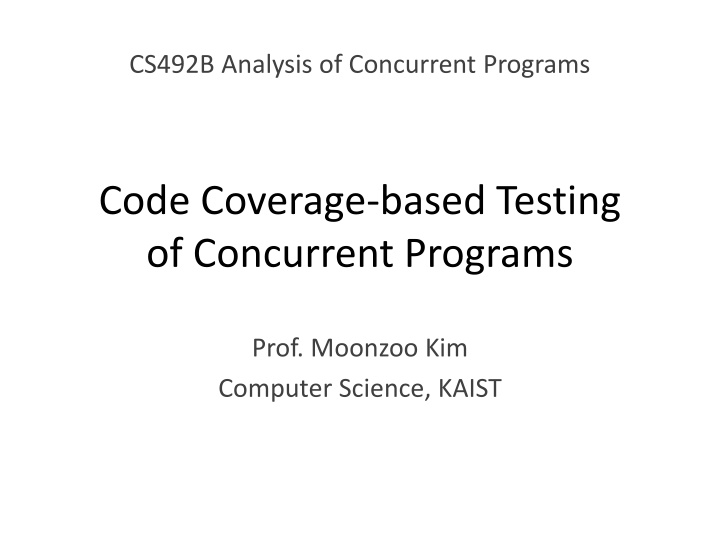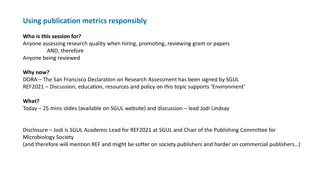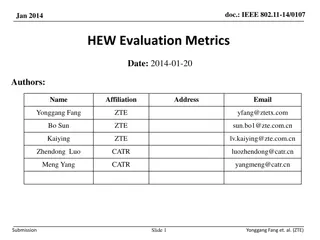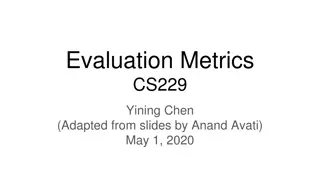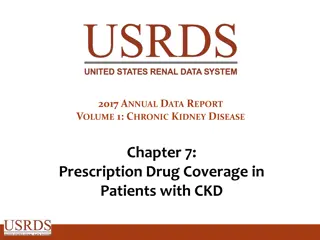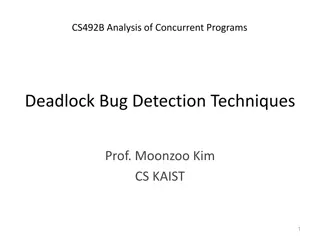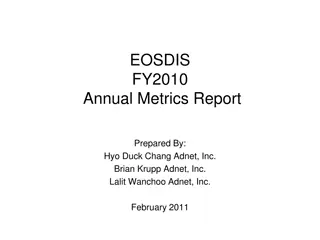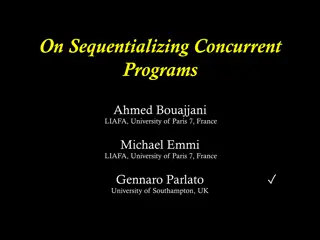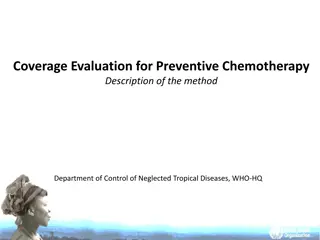Coverage-based Testing of Concurrent Programs: Analysis & Metrics
This analysis delves into the importance of coverage-based testing for concurrent programs, exploring code coverage metrics, test generation techniques, and the impact of concurrency coverage metrics on testing effectiveness. It discusses how concurrency coverage metrics derive test requirements, overcome limitations, and improve fault detection in concurrent program testing.
Download Presentation

Please find below an Image/Link to download the presentation.
The content on the website is provided AS IS for your information and personal use only. It may not be sold, licensed, or shared on other websites without obtaining consent from the author.If you encounter any issues during the download, it is possible that the publisher has removed the file from their server.
You are allowed to download the files provided on this website for personal or commercial use, subject to the condition that they are used lawfully. All files are the property of their respective owners.
The content on the website is provided AS IS for your information and personal use only. It may not be sold, licensed, or shared on other websites without obtaining consent from the author.
E N D
Presentation Transcript
CS492B Analysis of Concurrent Programs Code Coverage-based Testing of Concurrent Programs Prof. Moonzoo Kim Computer Science, KAIST
Coverage Metric for Software Testing A coverage metric defines a set of test requirements on a target program which a complete test should satisfy A test requirement (a.k.a., test obligation) is a condition over a target program An execution covers a test requirement when the execution satisfies the test requirement The coverage level of a test (i.e., a set of executions) is the ratio of the test requirements covered by at least one execution to the number of all test requirements A coverage metric is used for assessing completeness of a test Measure the quality of a test (to assess whether a test is sufficient or not) Detect missing cases of a test (to find next test generation target) 2 Code Coverage-based Testing of Concurrent Programs
Code Coverage Metric and Test Generation A code coverage metric derives test requirements from the elements of a target program code Standard methodology in testing sequential programs E.g. branch/statement coverage metrics Many test generation techniques for sequential programs aim to achieve high code coverage fast Empirical studies have shown that a test achieving high code coverage tends to detect more faults in the sequential program testing domain 3 Code Coverage-based Testing of Concurrent Programs
Concurrency Code Coverage Metric Many concurrency coverage metrics have been proposed, which are specialized for concurrent program tests Derive test requirements from synchronization operations or shared memory access operations A concurrency coverage metric is a good solution to alleviate the limitation of the random testing techniques Is a test achieving higher concurrency coverage better for detecting faults? How can we generate concurrent executions to achieve high concurrency coverage? How can we overcome the limitations of existing concurrency coverage metrics? 4 Code Coverage-based Testing of Concurrent Programs
Part I. The Impact of Concurrent Coverage Metrics on Testing Effectiveness
Code Coverage for Concurrent Programs Test requirements of code coverage for concurrent programs capture different thread interaction cases Several metrics have been proposed Synchronization coverage: blocking, blocked, follows, synchronization-pair, etc. Data access coverage: PSet, all-use, LR-DEF, access-pair, statement-pair, etc. 01: int data ; 10: thread1() { 11: lock(m); 12: if (data ){ 13: data = 1 ; ... 20: thread2() { 21: lock(m); 22: data = 0; ... 29: unlock(m); ... 18: unlock(m); ... Sync.-Pair: {(11, 21), (21,11), } Stmt.-Pair: {(12, 22), (22,13), } 6 Code Coverage-based Testing of Concurrent Programs
Concurrent Coverage Example follows Coverage Structure: a requirement has two code lines of lock operations <l1, l2 > Condition: <l1, l2 > is covered when 2 different threads hold a lock consecutively at two lines l1and l2 20:thread2() { 21: lock lock(m) ; 22: unlock unlock(m) ; 23: lock lock(m) ; 24: unlock unlock(m) ; 25:} 10:thread1() { 11: lock lock(m) ; 12: unlock unlock(m) ; 13: lock lock(m) ; 14: unlock unlock(m) ; 15:} - thread1() - lock(m) 12: unlock unlock(m) - thread2()- <11, 21>, <11, 23>, <13, 21>, <13, 23>, <21, 11>, <21, 13>, <23, 11>, <23, 13> 11: lock <11, 21> is covered 21: lock lock(m) 22: unlock unlock(m) 23: lock lock(m) 24: unlock unlock(m) <23, 13> is covered 13: lock lock(m) 14: unlock unlock(m) 7 Code Coverage-based Testing of Concurrent Programs
Is Concurrent Coverage Good for Testing? A common belief about concurrent coverage metrics is that As more test requirements for the metrics are covered, testing becomes more likely to detect faults . A few automated testing techniques for concurrent programs utilize concurrent coverage information recently Saturation-based testing [Sherman et al., ESEC/FSE 09], Coverage-guided systematic testing [Wang et al., ICSE 11], Coverage-guided thread scheduling [Hong et al., ISSTA 12], Search-based testing w/ concurrent coverage [Krena et al., PADTAD 10] Is this hypothesis really true? - We have to provide empirical evidence 8 Code Coverage-based Testing of Concurrent Programs
Research Questions 1 Does coverage impact fault finding? coverage metric A Fault finding coverage metric B coverage metric C Coverage Measure correlation of fault finding and coverage to check whether concurrent coverage is a good predictor of testing effectiveness 9 Code Coverage-based Testing of Concurrent Programs
Research Questions 1a Does coverage impact fault finding more than test suite size ? Fault finding Fault finding A + 5 executions A Coverage Test suite size Because of coverage increase ? Because of test size increase? Compare the correlation of fault finding and test suite size 10 Code Coverage-based Testing of Concurrent Programs
Research Question 2 Is testing controlled to have high coverage more effective than random testing with equal size test suites? Coverage Coverage t1 t'1 t2 t3 t'2 t'3 + ) + ) Random test suite: a test suite having arbitrary three executions Coverage controlled test suite: a test suite controlled to have 100% coverage Does a coverage-directed test suite have better fault finding ability than random test suite of equal size? 11 Code Coverage-based Testing of Concurrent Programs
Concurrent Coverage Metric Studied Study 8 concurrent coverage metrics Select basic & representative metrics from 20 existing metrics The selected coverage metrics are classified with respect to (1) type of constructs and (2) number of code element Synchronization operation Data access Operation blocking, blocked [Edelstein et al., 2012] Singular LR-Def [Lu et al., FSE 07] blocked-pair, follows [Trainin et al, PADTAD 09], sync-pair [Hong et al., ISSTA 12] Pset [Yu et al, ISCA 09], Def-Use [Tasiran et al., ESE 12] Pairwise 12 Code Coverage-based Testing of Concurrent Programs
Experiment Subjects Faulty versions Single fault programs 6 programs in concurrency bug bench. [Neha et al., PADTAD 09] Each program has a fault with low error density [Dwyer et al., FSE 06] Mutation testing Generate 34~88 incorrect versions (valid mutants) for each program Used concurrent mutation operators [Bradbury et al., MUTATION 06] Each version is created by applying one mutation operator once 13 Code Coverage-based Testing of Concurrent Programs
Experiment Process - Single Fault Programs Step 1. Generate test executions Use 13 random testing configurations Generate 1000 executions per testing configuration Step 2. Construct test suites by resampling test executions Generate 100,000 random test suites of sizes 1 1000 Generate 100 test suite controlled to achieve maximum overage per metric Step 3. Measure metrics for test suites Measure 8 coverage metrics Measure fault finding 800 test suites (=8 100) Program w/ fault Testing 13000 executions (=13 1000) Test executions Test suite construction Coverage controlled test suites (max. coverage) Random test suites (size: 1~1000) 100,000 test suites 14 Code Coverage-based Testing of Concurrent Programs
Experiment Process Mutation Testing Faulty versions Step 1. Generate test executions Use 13 random testing configurations Generate 2000 executions per mutant and per testing configuration Step 2. Construct test suites by resampling test executions Generate 100,000 random test suites of sizes 1 2000 per mutant Generate 100 test suites controlled to achieve maximum coverage per mutant and per coverage metric Step 3. Measure metrics for test suites Measure 8 coverage metrics Measure fault finding (mutation score) Version 1 Version 2 VersionM 51 mutants for Vector Testing 1,326,000 executions for Vector (= 51 13 2000) Test executions Test suite construction Coverage controlled test suites (max. coverage) 40,800 (=51 8 100) Random test suites (size: 1~2000) 5,100,000 (= 51 100,000) 15 Code Coverage-based Testing of Concurrent Programs
RQ 1: Does Coverage Achieved Impact Fault Finding ? Compute the correlations of coverage metrics and fault finding as well as the correlations of test suite size and fault finding by Pearson s r Results of mutation testing subjects Coverage metrics have stronger correlations than test suite size Ex. Vector Corr. Size-FF Sync-pair PSet LR-DEF Follows Def-Use Blocking Blocked-pair Blocked 0 0.2 0.4 0.6 0.8 1 Corr. cov. and fault finding 16 Code Coverage-based Testing of Concurrent Programs
RQ 1: Does Coverage Achieved Impact Fault Finding ? Results of single fault subjects There is a coverage metric having high correlation for each subject Ex. Stingbuffer Corr. Size-FF Sync-pair PSet LR-DEF Follows Def-Use Blocking Blocked-pair Blocked RQ 1: Is concurrent coverage good predictor of test. effectiveness? Yes.The metrics estimatefaultfinding of a testingproperly 0 0.2 0.4 0.6 0.8 1 Corr. cov. and fault finding Corr. cov. and fault finding 17 Code Coverage-based Testing of Concurrent Programs
RQ 2: Does Coverage Controlled Testing Detect More Faults? Compare fault finding of a coverage-controlled test suite w.r.t. a metric M and fault finding of random test suite of equal size Results of mutation testing Ex. ArrayList * Cov FF / Random FF: fault finding of controlled test suites/random test suite (0~8.5) Reduced FF Cov FF Random FF Random FF Fault finding Fault finding 8 7 6 5 4 3 2 1 0 blocking blocked LR-Def blocked-pair Def-Use follows PSet Sync-pair 18 Code Coverage-based Testing of Concurrent Programs
RQ 2: Does Coverage Controlled Testing Detect More Faults? Results with single fault programs Generally, controlled test suites have higher fault finding abilities than random ones Coverage metrics have different performances depending on programs Ex. Stringbuffer * Cov. FF / Random FF: fault finding of coverage controlled test suites /random test suite (0~1) Fault finding Fault finding Reduced FF Cov FF Random FF Random FF 1 0.9 0.8 0.7 0.6 0.5 0.4 0.3 RQ 2: Is concurrent coverage proper for test generation ? Yes. Generating test suites toward high coverage can detect more faults than random test generation 0.2 0.1 0 blocking blocked Code Coverage-based Testing of Concurrent Programs LR-Def blocked-pair Def-Use follows PSet Sync-pair 19
Lessons Learned: Concurrent Coverage is Good Metric 1. Use concurrent coverage metrics to improve testing! Good predictor of testing effectiveness Good target for test generation 2. PSet is the best pairwise coverage metric used alone High correlation with fault finding in general High fault finding for controlled test suites w.r.t. PSet in all subjects 3. PSet + follows would be better than just a metric alone For some objects, there is a large difference in fault finding depending on metrics A combined metric of data-access based and synchronization- based coverage would provide reliable performance in general 20 Code Coverage-based Testing of Concurrent Programs
Part II. Testing Concurrent Programs to Achieve High Synchronization Coverage 21 Code Coverage-based Testing of Concurrent Programs
Overview A testing framework for concurrent programs To achieve high test coverage fast Key idea 1. Utilize coverage to test concurrent programs systematically 2. Manipulate thread scheduler to achieve high coverage fast Test run Measure coverage thread1() { 10: lock(m) Thread scheduling controller ... {(10,20), } Covered SPs 15: unlock(m) Coverage estimator {(10,20), (20,10), } ... thread2() { 20: lock(m) ... Estimated target SPs {(20,10), } Uncovered SPs 30: unlock(m) Threads Estimation phase Testing phase 22 Code Coverage-based Testing of Concurrent Programs
Synchronization-Pair (SP) Coverage Def. A pair of code locations < ??,??> 10:foo() { 20:bar() { lock(m) 11: synchronized synchronized(m){ 21: synchronized synchronized(m){ is a SP coverage requirement, if 12: } 22: } unlock(m) (1) ?1and ?2are lock statements 13: synchronized synchronized(m){ 23: synchronized synchronized(m){ 14: } 24: } (2) ?1and ?2hold the same lock ? 15:} 25:} (3) ?2holds ? right after ?1releases ? --Thread1: foo()-- --Thread2: bar()-- 11: synchronized synchronized(m){ 12: } Covered SPs: (11, 21), (21, 23), (23, 13) 21: synchronized synchronized(m){ 23: } (11, 21) is covered 23: synchronized synchronized(m){ 24: } (21, 23) is covered 13: synchronized synchronized(m){ 14: } (23, 13) is covered 23 Code Coverage-based Testing of Concurrent Programs
Synchronization-Pair (SP) Coverage Def. A pair of code locations < ??,??> 10:foo() { 20:bar() { 11: synchronized synchronized(m){ 21: synchronized synchronized(m){ is a SP coverage requirement, if 12: } 22: } (1) ?1and ?2are lock statements 13: synchronized synchronized(m){ 23: synchronized synchronized(m){ 14: } 24: } (2) ?1and ?2hold the same lock ? 15:} 25:} (3) ?2holds ? right after ?1releases --Thread1: foo()-- --Thread1: foo()-- --Thread2: bar()-- --Thread2: bar()-- 11: synchronized synchronized(m){ 12: } 11: synchronized synchronized(m){ 12: } 21: synchronized synchronized(m){ 22: } 21: synchronized synchronized(m){ 22: } 23: synchronized synchronized(m){ 24: } 13: synchronized synchronized(m){ 14: }Covered SPs: (11, 21), (21, 13), (13, 23) Covered SPs: (11, 21), (21, 23), (23, 13) 13: synchronized synchronized(m){ 14: } 23: synchronized synchronized(m){ 24: } 24 Code Coverage-based Testing of Concurrent Programs
Testing Framework for Concurrent Programs (1)Estimates SP requirements, (2)Generates test scheduling by monitor running thread status, and measure SP coverage suspend/resume threads to cover new coverage req. Test run Measure coverage thread1() { 10: lock(m) Thread scheduling controller ... {(10,20), } Covered SPs 15: unlock(m) Coverage estimator {(10,20), (20,10), } ... thread2() { 20: lock(m) ... Estimated target SPs {(20,10), } Uncovered SPs 30: unlock(m) Threads Estimation phase Testing phase 25 Code Coverage-based Testing of Concurrent Programs
Thread Scheduling Controller Coordinates thread executions to satisfy new SP requirements Invokes an operation (1) before every lock operation, and (2) after every unlock operation Controls thread scheduling by (1) suspend a thread before a lock operation (2) select one of suspended threads to resume using three rules {(10,20), } Covered SPs ... Decide whether suspend, or resume a current thread invoke thread scheduler {(20,10), } Uncovered SPs 10: synchronized(m) { 11: if (t > 0) { 12: ... Other threads status 26 Code Coverage-based Testing of Concurrent Programs
Thread Schedule Decision Algorithm (1/3) Rule 1: Choose a thread to cover uncovered SP directly Thread 2 Thread1 - Covered SPs: (20, 22) - Uncovered SPs: (10,22),(10,22), (20,10) 20: lock(m) ,(20,10) 21: unlock(m) 10: 10: 22: lock(m) lock(m) lock(m) 27 Code Coverage-based Testing of Concurrent Programs
Thread Schedule Decision Algorithm (2/3) Rule 2: Choose a thread to cover uncovered SP in next decision Thread 2 Thread1 Thread1 - Covered SPs: (20,10),(20,22), (10,22) - Uncovered SPs: (22,10) 20: lock(m) 21: unlock(m) 22: 22: 10: lock(m) lock(m) lock(m) 28 Code Coverage-based Testing of Concurrent Programs
Thread Schedule Decision Algorithm (2/3) Rule 2: Choose a thread to cover uncovered SP in next decision Thread 2 Thread 2 Thread1 Thread1 - Covered SPs: (20,10),(20,22), (10,22),(22,10) - Uncovered SPs: (22,10) 20: lock(m) 25: 21: unlock(m) unlock(m) 22: lock(m) 10: lock(m) 29 Code Coverage-based Testing of Concurrent Programs
Thread Schedule Decision Algorithm (3/3) Rule 3: Choose a thread that is unlikely to cover uncovered SPs Thread 2 Thread1 - Covered SPs: (20,10),(10,20), (20,22),(10,22), (22,10) 20: lock(m) 21: unlock(m) - Uncovered SPs: (10,60),(70,22), - Uncovered SPs: (10,60),(70,22), (80,22),(10,50), (80,22),(10,50), - Uncovered SPs: (10,60),(70,22), (80,22),(10,50), (22,60) (22,60) (22,60) 10: 10: 22: lock(m) lock(m) lock(m) schedule Thread 1: Since Thread 2 with line 22 remains under control, more chance to cover (70, 22), (80, 22), (22, 60) schedule Thread 2: Since Thread1 with line 10 remains under control, more chance to (10, 60), (10, 50) 30 Code Coverage-based Testing of Concurrent Programs
Empirical Evaluation Implementation [Thread Scheduling Algorithm, TSA] Used Soot for estimation phase Extended CalFuzzer 1.0 for testing phase Built in Java (about 2KLOC) Subjects 7 Java library benchmarks (e.g. Vector, HashTable, etc.) (< 11 KLOC) 3 Java server programs (cache4j, pool, VFS) (< 23 KLOC) 31 Code Coverage-based Testing of Concurrent Programs
Empirical Evaluation Compared techniques We compared TSA to random testing We inserted probes at every read, write, and lock operations Each probe makes a time-delay d with probability p d: sleep(1ms), sleep(1~10ms), sleep (1~100ms) p : 0.1, 0.2, 0.3, 0.4,0.5 We use 15 (= 3 x 5) different versions of random testing Experiment setup Executed the program 500 times for each technique Measured accumulated coverage and time cost Repeated the experiment 30 times for statistical significance in results 32 Code Coverage-based Testing of Concurrent Programs
Study 1: Effectiveness TSA covers more SPs than random testings for accumulated SP coverage after 500 executions Our technique RND-sleep(<100ms) avg. RND-sleep(<10ms) avg. SP coverage RND-sleep(1ms) avg. ArrayList 1 test executions 33 Code Coverage-based Testing of Concurrent Programs
Study 2: Efficiency TSA reaches the saturation point faster and higher A saturation point is computed by r2 (coefficient: 0.1, window size: 120 sec.) [Sherman et al., FSE 2009] Saturation point Our technique SP coverage RND-sleep(<10ms) avg. RND-sleep(<100ms) avg. RND-sleep(1ms) avg. ArrayList 1 time (sec) 34 Code Coverage-based Testing of Concurrent Programs
Study 3: Impact of Estimation-based Heuristics (Rule3) TSA with Rule3 reaches higher coverage at faster saturation point Executes the program for 30 minutes, and computed the saturation points > 90% of thread scheduling decisions are made by the Rule 3 TSA w/o Rule 3 Coverage 177.6 130.8 151.3 98.0 23.7 539.6 179.9 129.9 151.6 98.8 201.9 T/O 246.7 TSA with Rule 3 Coverage 181.2 141.4 151.7 120.8 24.0 538.0 181.2 141.2 151.4 120.5 202.2 2950.5 260.1 Program time (sec) 274.4 time (sec) ArrayList1 ArrayList2 HashSet1 HashSet2 HashTable1 HashTable2 LinkedList1 LinkedList2 TreeSet1 TreeSet2 cache4j pool VFS 274.4 246.3 271.5 198.9 120.0 388.8 278.2 237.7 258.4 237.5 205.8 T/O 478.2 184.2 159.7 172.4 139.3 120.0 165.4 155.0 161.2 191.2 139.8 146.1 431.1 493.9 177.6 181.2 184.2 TSATSA w/o rule3 35 Code Coverage-based Testing of Concurrent Programs
Contributions and Future Work Contributions Thread scheduling technique that achieves high SP coverage for concurrent programs fast Empirical results that show the technique is more effective and efficient to achieve high SP coverage than random testing Future works Study correlation between coverage achievement and fault finding in testing of concurrent programs Extend the technique to work with other coverage criteria 36 Code Coverage-based Testing of Concurrent Programs
